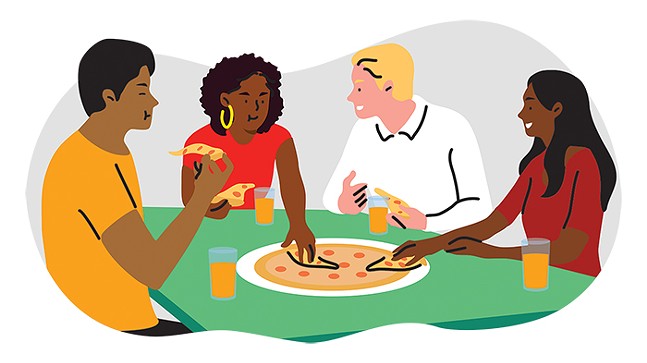Before Bring your Daughter to Work day, there was an annual Take a Negro to Lunch day. What is unclear to me is if the proposed luncheon was connected to National Brotherhood (!) Week, both events tokenized tolerance-apaloozas. It’s easy to look back and cringe, laugh, and shake our 21st-century, very woke AF heads.
However, the idea of Take a Negro to Lunch is so very timely in this era of commodified Black Lives Matter messaging; motivated by the desire to appear down, if not committed to real equity and justice, but well-meaning, trying.
Well meaning and trying.
The idea of Take a Negro to Lunch is steeped in a long standing and still practiced process of vetting the right kind of Black person. I first returned to Pittsburgh in 2002 to work for a local nonprofit public policy organization; by 2003, I knew I was not the Right Kind of Black Person, so I was on my way to Kenya in 2004.
There is usually only one of these lucky (?) Black people per table, organization, room. OK, maybe three, tops. Now, if you just paused to count the Black people on your company’s Zoom call, you are proving my point. Even if the number is higher than three, equitable representation is rare or nonexistent in Pittsburgh. A recent study on “occupational segregation” by the University of Pittsburgh’s University Center for Social and Urban Research shows the lack of representation of African American people across professions in our region.
The 2020 BLM version of this luncheon is to move beyond the individual and look to support, uplift, center, and focus on Black-led organizations and companies. This is the well-meaning and trying part, which is important, necessary, and overdue. Please continue. But what happens all too often is that the same Black entities get picked. Again and again.
Information is gathered on what is the Right Kind of Black Organization from the same articles, posts, and segments circulated among white folks from white-led, white-legacy media. What is left out is the due diligence of actually creating and connecting with the Black community. For a quick fix, to appear to be doing something, anything for racial justice, too many white organizations are just cutting and pasting what someone else has done.
Because of the deep segregation of the Pittsburgh region, white-led organizations do not really know who to call to ask, “Who do we partner with, support?” Because these white-legacy organizations have no practice in racial equity and justice, they often turn to tokenism, the most distributed, discussed, and applied model for racial “equity“ to date.
BLM-washing, similar to green washing in the environmental movement, where “sustainability” has long been co-opted, the current anti-racism work is benefiting a few wonderful and worthy organizations. To be clear, they deserve every dollar they are receiving and more. But what about real distribution of power, resources, and access?
The summer of George Floyd and Breonna Taylor inspired many white-led, white-legacy organizations to do much-needed soul searching. But this process of becoming an equitable and just city, region, and country will take real effort. Creating relationships with Black Pittsburgh in all its complexity, contractions, multiplicity, legacy, and beauty takes openness, honesty of goals, and “put your elbows” in work.
There is no easy road to these connections, not here in Pittsburgh, especially not here, where honest conversations about racial disparity are met with gaslighting on a regular basis. Where social media posts on “Another List About How Great Pittsburgh Is To Live” are shared more often than real talk about how much work needs to be done for this to be true for all of us.
Just as COVID-19 has shown the fragility of “women in the workplace” despite decades of Taking Your Daughters to Work, similar tokenism like a one-time or even cyclical BLM partnership is not enough.
To begin the real work of equity and justice, “Lunch” would include going to the local market, buying the ingredients together, listening and learning the meaning of each one. Sitting together, watching the meal being prepared, and maybe, if invited, helping in its preparation. You are not inviting a Black person to your table, you’re learning how to earn a place and invitation into a Black space. Be worthy, be honest, be open, be prepared to fail and succeed, for the long haul, for more than a day, a week, or a year.


